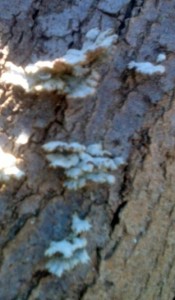Following the publication of my 2013 Journal article about lichens on trees, Brian Brock wrote to me, saying “Dear Steve, your lichen-like growth on page 6 of the (2013) Journal (see photo below) may be a thin fruiting bracket (‘conk’?) of a wood decaying fungus.
A lichen-like growth on a coastal tree at Semaphore beach
(Taken with iPhone by Steve Reynolds)
If you (had) looked under the bracket, you might (have seen) small pores that carry the fertile layer (from which spores are shed).
I have, at last, located two of my main fungi books. On page 129 of Bruce Fuhrer’s 1985 book “A Field Companion to Australian Fungi” (The Five Mile Press) there is a colour photo of brackets of a wood destroying fungus called Trametes versicolour. He says the under surface is cream and covered with small pores. The photo looks very much like yours. He calls it ‘Rainbow Fungus’. It is probably the species JB Cleland called Polystictus versicolour on pages 217-8 and figure 48 (p.281) of “Toadstools & Mushrooms & Other Larger Fungi of South Australia” (1976 reprint, Government Printer SA).
A spore print can be obtained by putting a bracket with the pored surface down on a bit of black paper. Put an empty glass over the bracket to create a still-air chamber. The spores fall down and make a print that could be fixed with hair spray. For dark spores, use white paper. You could probably Google ‘basidia & ‘spores of Polypores’ (many-pored fungi) for more information (or look in the Britannica).”
I ‘Googled’ (Bing actually) ‘basidia & spores of Polypores’, which led me to What’s A Mushroom for starters. There is even a photo of Trametes versicolour (a.k.a.the Turkey tail/Turkeytail) there.
According to Wikipedia, “Polypores are a group of fungi that form fruiting bodies with pores or tubes on the underside (see ‘Delimitation’ for exceptions). They are a morphological group of basidiomycetes like gilled mushrooms and hydnoid fungi, and not all polypores are closely related to each other. Polypores are also called bracket fungi, and their woody fruiting bodies are called conks. Most polypores inhabit tree trunks or branches consuming the wood, but some soil-inhabiting species form mycorrhiza with trees. Polypores and their relatives, corticioid fungi are the most important agents of wood decay. Thus they play a very significant role in nutrient and carbon cycle of forest ecosystems.”
REFERENCES
- “Adaptation of some Coastal Species” by Brian Brock, MLSSA Journal 2013
- “A Field Companion to Australian Fungi” by Bruce Fuhrer, 1985 (The Five Mile Press)
- “Toadstools & Mushrooms & Other Larger Fungi of South Australia” by JB Cleland, 1976 (Government Printer SA)


My article above started off by suggesting that the “lichen-like growth on page 6 of the (2013) Journal … may be a thin fruiting bracket (‘conk’?) of a wood decaying fungus”. Brian Brock has since written to me again, saying “Many of the polypores do have “woody fruiting bodies” entitled to the word “conk”. However, I would hesitate to use the word for the thin leathery fruiting body of “Trametes versicolor” (NOT “versicolour”).” (The problem with the variation in the spelling of colour/color seems to be interference by the computer or the website software being used. We may yet be able to edit the original article.)
According to the web page found at https://www.sciencedaily.com/releases/2016/07/160721151213.htm#.V5F4xrECIYw.facebook , “For nearly 150 years, lichens have been the model organisms of symbiosis. Now researchers have uncovered an unexpected third partner embedded in the lichen cortex or “skin” — yeast.
Since 1867, scientists have recognized the fundamental partnership that produces lichens: A fungus joins with an alga or cyanobacteria in a relationship that benefits both individuals. In a study led by the University of Montana and co-authored by Purdue mycologist M. Catherine Aime, researchers show that lichens across six continents also contain basidiomycete yeasts, single-celled fungi that likely produce chemicals that help lichens ward off predators and repel microbes.
The finding could explain why many genetically similar lichens present wildly different physical features and why scientists have been unable to synthesize lichens in the laboratory, even when combining species that partner successfully in nature.”